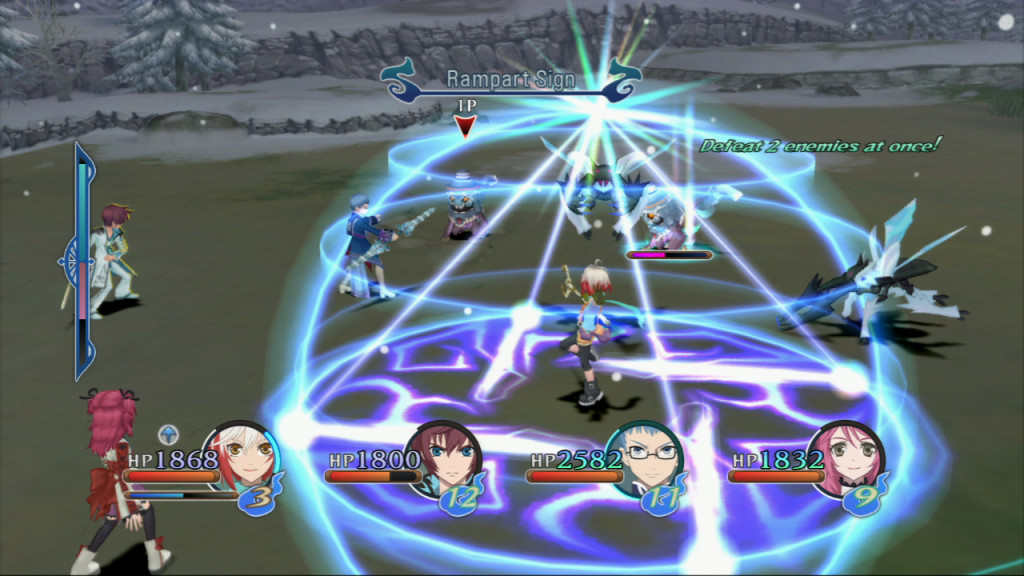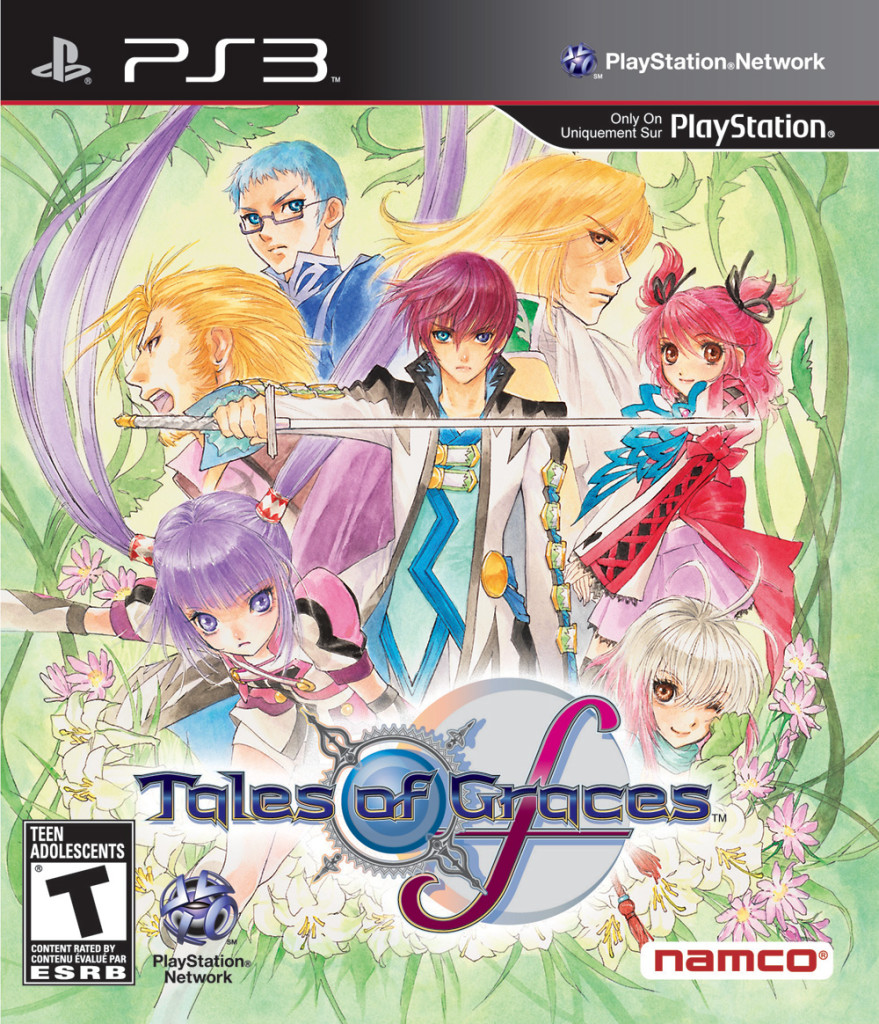Last updated on May 27, 2013
This isn’t an entry I wanted to write, but I need to be honest with the readers or lose my street cred.
I am enjoying Tales of Graces F a great deal. In fact, it’s the most fun I have had with a Japanese role-playing game since the last Tales game I played, Vesperia. Something about this series pushes all my stupid enjoyment buttons: the sappy melodrama, the incredibly predictable tropes, anime characters talking about exposition, political themes in half-fantasy, half-science fiction settings, techno/magic babble spoken with the utmost of seriousness, and the common theme of FRIENDSHIP CONQUERS ALL.
It’s exactly the kind of game people would call a “guilty pleasure”, but I say if you like it, you like it. It doesn’t hurt that Namco crams excellent crafting and battle systems into the game, making the simple act of walking from generic plot-point to generic plot-point a fascinating and exciting one. In this case, we get “dualizing”, which makes the process of buying items at a store nearly obsolete. Basically, you combine two compatible materials together (hence the “dual” part) to form new items, weapons, armors, or to just enhance said weapons and armor from their base forms. Unlike in most games, where getting to a new town means an obvious trip to the Equipment vendor, here the process becomes quite difficult.
Usually in JRPGs you’ll need to grind lots and lots of money to get new stuff, and THEN to upgrade it, but there’s actually a decision-making process here. Who’s gear should I upgrade? Should I upgrade person X over Y, based on usage (only four party members in battles)? Dualizing’s a cost-heavy process for the better items; rare materials exist in slight quantities, so you better make some good decisions. Like any good game, it won’t break your ability to finish battles, of course, but it’s a system that forces decisions on your part that actually matter. You can certainly grind if you wish, but it’s not entirely necessary.
Of course, Tales’ most notable feature means that you will want to grind, and that comes from its innovative, fast-paced, and absolutely BONKERS real-time battle system. The Japanese call it the “Linear Motion Battle System”; think of a 3d arena with the ability to move linearly towards foes and switch targets on the fly, and that’s about the gist of it. Add in combo attacks, special move, magic attacks, a super meter in the form of Eleth Burst (even enemies have it) and dodging (yes, actual dodging of attacks under your control) and you got yourself a heck of a battle system. All maneuvers operate on a certain number of CC, a currency that regenerates when you’re not doing anything (or blocking). Dodging and dashing also cost CC, so planning your attacks/dodging in advance helps a great deal…even if said planning happens on the fly.

Every enemy encounter, especially on higher difficulties, becomes an intense game of focusing on the most difficult targets, finding their weakness (helpfully displayed when using the switch target option), and slamming them with it. Many enemies, smartly enough, focus on your healers/casters, forcing you to divert their attention…or, perhaps, running away when you see them coming. You only play as one of four characters, and the AI controls the rest. You need to arrange the battle in advance so that the odds tip to your favor, usually by dictating what abilities they use. This comes into play during boss fights, which usually require you to sit back and think how you want to approach a situation.
In all honesty, I didn’t expect the game’s difficulty to ramp up so quickly. I felt the game didn’t take me to task at first, so I set the battles on Hard. Placing the game on higher difficulties makes battles a TON more fun, relying mostly on strategy and good timing to win. It makes even the simplest encounters a mental test of wits. However, and here’s where the complaints start to emerge, boss battles become absolute terrors. I’m not sure why this is, and someone more knowledgeable about the Tales series could certainly correct me, but the bosses become huge setpieces AND impossible obstacles.
Now, this still remains a JRPG, and that means grinding inevitably becomes a part of it (well, other than Chrono Trigger, but that’s an outlier on the whole genre even now). But seriously, these bosses on Hard (and probably on Evil and Chaos – two steps beyond Hard) feel utterly ridiculous. No matter the strategy, no matter your group composition, skills, or anything else people associate with video games, you just cannot beat them. Except by…grinding. Imagine that! It comes down to a numbers game at a point, and that’s where I find myself wholly unsatisfied with the “challenge” presented here. It’s little more than an excuse for silly padding, not actual game content. The battle system touts itself as strategy and skill-based, so why change that? Why tune the higher difficulties simply to make people do the same repetitive task over and over? Not even dualizing can extricate you from this situation.
Game design is a tough job, that much is for certain. Developers need to spend their resources in one area or another, and sometimes graphics/sound/script/etc take the place of a more rigorous design. Just compare Tales’ difficulty levels to anything PlatinumGames put out in the past five years, and you’ll see intricate design without filler. It’s obvious, then, that they tuned Tales of Graces F (the PS3 version) for Normal mode. I’m fine with that, but switching back to Normal basically makes the fights trivial due to the experience bonus you get from Hard mode. That’s not good game design, folks! Being able to change the challenge of an obstacle at will means you will make it through the game, but it also leaves a bit of an empty feeling inside.
I nearly refused to do this. I never do this; I would never change it. But two Dispaters later, stupid dragon birds of death that seem nigh unkillable at my current experience level, forced me to reconsider. I just couldn’t take the horrible imbalance anymore and wasn’t willing to do pointless battle busywork for hours just to retry it again. The boss barely posed a challenge. It made me feel dirty, but it made me feel worse for taking the fruit. Knowing that I can remove an obstacle, and that the designers left it there at my control shows they had no faith in me or in their game systems and balance. That’s a bit of a harrowing thought.
We could call it similar to the Fall of Man in Genesis 3: the tree’s left before us, and all it takes is a little push to take away the idealism and turn it into cynicism. What was once pure and holy becomes damnable and profane, and all it takes is a simple switch from green to red.
Now the serpent was more crafty than any beast of the field which the Lord God had made. And he said to the woman, “Indeed, has God said, ‘You shall not eat from any tree of the garden’?” 2 The woman said to the serpent, “From the fruit of the trees of the garden we may eat; 3 but from the fruit of the tree which is in the middle of the garden, God has said, ‘You shall not eat from it or touch it, or you will die.’” 4 The serpent said to the woman, “You surely will not die! 5 For God knows that in the day you eat from it your eyes will be opened, and you will be like God, knowing good and evil.” 6 When the woman saw that the tree was good for food, and that it was a delight to the eyes, and that the tree was desirable to make one wise, she took from its fruit and ate; and she gave also to her husband with her, and he ate. 7 Then the eyes of both of them were opened, and they knew that they were naked; and they sewed fig leaves together and made themselves loin coverings.
Still, the situation’s up to us; we don’t need to give into the temptation, and I refuse to give up with Tales of Graces. I honestly had a great time for playing a game with such a major flaw. In fact, I ratcheted the game back up to Hard afterward. There’s so much fun to be had that one little design flaw won’t stop me from completing it. I refuse to look on the negative side because the positives work so well.
Isn’t that how Christ looks at us? So it is in video games, so it is in real life.

